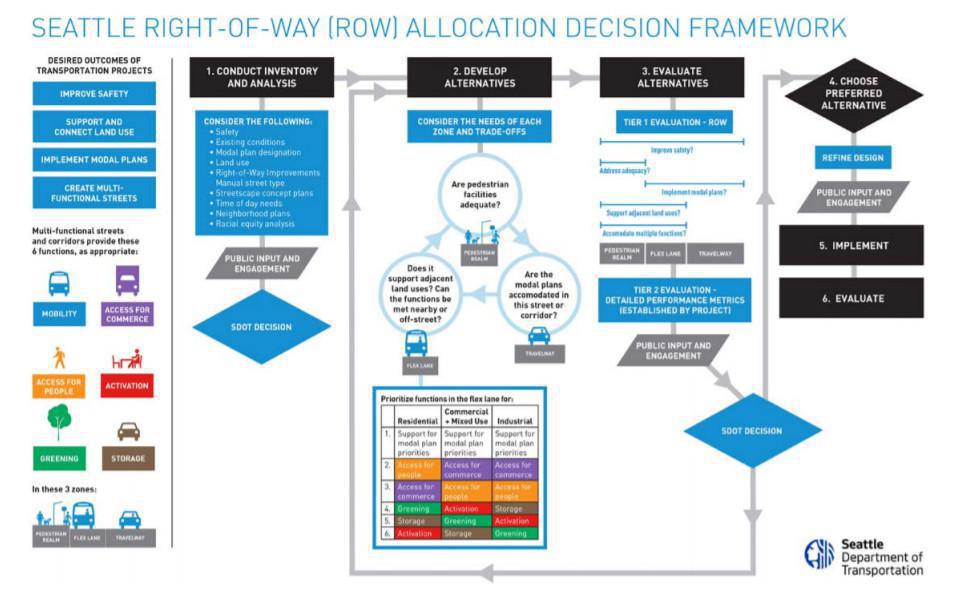Smart city, online retail and transportation technology are increasing competition for short-term curbside access. This is in addition to traditional public transit and on-street parking uses. To manage utilization, decrease curbside congestion, and capture value, more cities are seeking ways to better manage curbspace.
Benefits & Problems Addressed
Reduced curbside congestion: Pricing and new management techniques can help reduce congestion and blocked traffic flow.
Increased revenue from diverse sources: Current on-street parking is often un- or underpriced for users who occupy the space for long periods of time. Reallocating space for a high volume of short-term users helps increase vitality and economci activity.
Tips & Techniques
With stakeholders, establish a system of street designations according to their primary purpose. Streets serve a broad range of functions, from through-traffic routes to pedestrian thoroughfares. Practices to ensure safety and manage traffic flow will vary according to the principle purpose of each street section, which will need to be updated to include short term passenger and goods loading zones. With increased activities, alleys may see renewed interest for lessening congestion and conflict, while there could be pushback as more utilitarian uses are redirected to side streets.
Set priority curb uses, which can be segmented by time of day: Emergency responders and repair crews will still claim priority access. In addition, cities will also give priority to pedestrians, bicyclists and transit users, in particular travelers with special mobility needs. Since bike lanes are often next to the curb, increased vehicle activity and dooring will be critical design factors. Curbs are also critical infrastructure for stormwater management and hence new uses and hubs will need to take storm drains and manhole covers into account.
Context sensitivity: While congestion in urban areas tends to be a top concern, there are various other opportunities and challenges in suburban, exurban, rural and campus settings. In rural downtowns, managers often need to manage seasonal congestion, and pay more attention to transportation demand management as ridehailing expands. Because most curbs in non-urban settings are within private property, owners still need to pay attention to how their clients and users are accessing emerging modes of transportation and any uptick in deliveries.
Anticipate and plan for the revenue impacts of shifting curb use from car parking to passenger pick up and drop off. Changes in curb use will initially be small and confined to urban centers. Cities will need to anticipate demand and shift long term parking for new activity zones, as well as the technology needed to collect new access fees. In mapping reallocation, cities can look at data concerning congestion, activity and safety.
Align with other planning efforts: Other related plans and policies need to be coordinated to optimize curb management. This can include parking policies, small area planning and Vision Zero. Within district and small area plans, cities can create mobility hubs that co-locate transit, ridehailing and package deliveries. These hubs can be strategically planned to serve multiple buildings in space that does not impede traffic flow for pedestrian, bicyclists and vehicles.
Common standards and management systems for encoding and managing curb use. First, cities and towns will need to and inventory, map and code existing curbs. This allows automatic integration of curb and street use rules directly into third-party apps and algorithms and APIs. Common referencing standards for curb data would enable detailed knowledge of curb use rules and facilitate their monitoring.
Design, price and manage curb space dynamically so it adapts to different uses and users. Cities are already introducing flex lanes and parking spaces for parklets, bike corrals, markets and events. Technology allows even more flexibility to manage sidewalks, curbs and adjacent street space. Pricing can not only be applied to high-congestion periods, but also build in incentives, for example offering a lower price for pick-ups at designated hubs rather than in the middle of traffic. In addition, shift current licensing, permitting, operations and regulatory systems that manage taxis and parking to this more dynamic model. Finally, cities will need to determine how to allocate collected revenue.
Use of microsimulations: Given the unprecedented change in technology and transport, microsimulations can help reveal areas of concern such as congestion-inducement, pedestrian and bicyclist safety at intersections, spillover traffic, and tests for incentives/disincentives.
Data and Technology: Key data and performance measures relate to (1) Safety & reduction in crashes; (2) Street and intersection congestion; (3) Number/types of service vehicles & dwell time; (4) Public transport and cycling trips; (5) Bus travel speeds; (6) Parking enforcement citation trends; (7) Economic impact; and (8) Data sharing. There are several aspects of technology to consider including: (1) app-based revenue collection, (2) infrastructure-embedded technology, (3) cameras or other sensing technology, and (4) vehicle-based technology such as LIDAR.
Hot Buttons: Removing parking, pricing all users (including bicyclists, pedestrians and public transit agencies, Privacy and security for app-based payment schemes, transition to flexible streets, spillover traffic and parking; priority of speed over safety for curb use.
Resources
The Shared-Use City: Managing the Curb – OECD International Transport Forum
Curb Appeal: Curbside Management Strategies for Improving Transit Reliability White Paper – National Association of City Transportation Officials (NACTO), November 2017.
Curbside Management Practitioner's Guide, Institute for Transportation Engineers (ITE), 2018
Curbside Management: Managing Access to a Valuable Resource, The Parking Professional, May 2019.

